|
Fisher
Body - Home
Fisher Body Craftsmanship Goes to War
Fisher Body - Craftsmanship
Fisher Body - Aircraft
Fisher Body - Aircraft
Instruments
Fisher Body - Guns
Fisher Body - Tanks
Fisher Body - Miscellaneous
The Plants
Fisher Body WWII Plant Database
Cleveland Plant #1, OH Plant
Cleveland Plant #2, OH Plant
Detroit Aircraft Unit,
Detroit, MI
Detroit Die and Machine Plant
Fleetwood, Detroit, MI Plant
Flint Plant #1, MI Plant
Grand Blanc, MI Tank Arsenal
Grand Rapids, MI Plant
Lansing, MI Plant
Memphis, TN Plant
Ternstedt Manufacturing Division,
Detroit, MI
Grand Blanc Tank Arsenal Built Tanks and Tank Destroyers
Grand Blanc
built M4A2 Sherman Tank Photos
Grand Blanc
Built M4A3 Tank Photos
Grand
Blanc M10 Tank Destroyer Photos
Surviving Fisher Body Plants - General Motors Corporation in World War
Two
Detroit Die and
Machine Plant (Fisher Body Plant #23)
1920-19??
This page updated
2-12-2022.
The Fisher Body Die and Machine plant on
Piquette Avenue covered an entire city block between Beaubien and
Hastings Streets in the Milwaukee Junction area of Detroit. Parts
of the plant still exist today.
Fisher Body Die and Machine Plant
World War Two Production
Statistics: B-25, B-29, P-80 aircraft tools and fixtures; M4,
M10, M36, M26, M18 tank parts; three-inch and five-inch Naval
Gun Breech Housings, 155mm and eight-inch gun parts, Diesel Engine parts and Torqmatic Transmission parts.
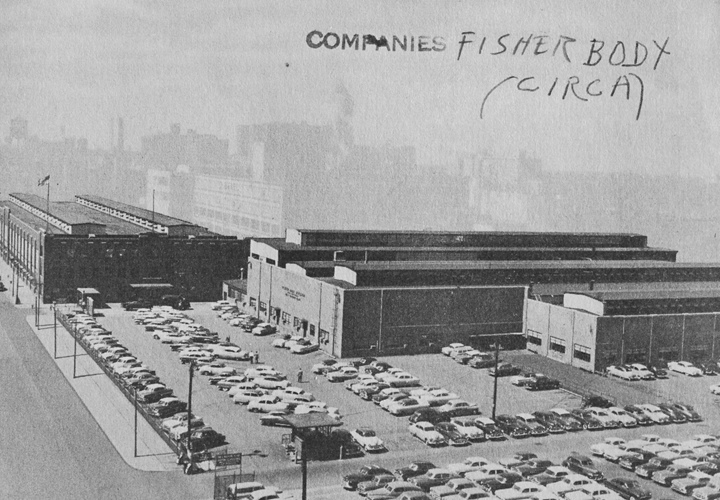
The Tool and Die plant in the 1950s'. The building in the photo below is in the upper left and is the
southwest corner.
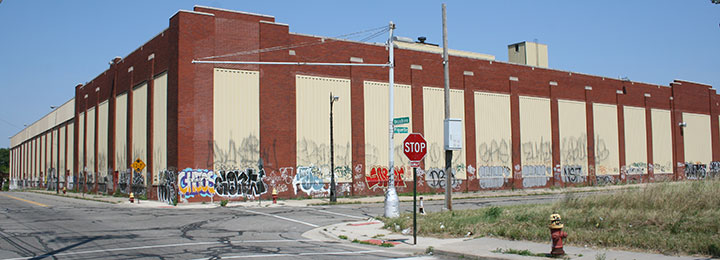
This is the former Fisher Body Detroit Die
and Machine Plant at the corner of Piquette Avenue and Beaubien Street
in Detroit, MI. It is still in use as a stamping plant under a new owner.
Author's Photo.
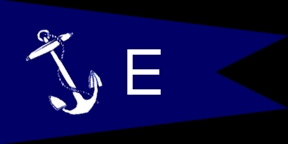
The Die and Machine Plant was the first auto company to receive the Navy
"E" for Excellence award. It would add six stars and keep its original Navy "E" Award
instead of converting it to the new Army-Navy "E" for Excellence award.
The original award (flag) was received in November 1941 for being
"ahead of schedule production" of five inch naval gun breeches.
The first star came six months later for "steady production"
five inch
naval gun breeches of in May 1942.
The second star was added for "uninterrupted production" five inch naval gun
breeches on November 10, 1942.
Four more stars were added at later dates during the war.
Only 4,283 plants out of 86,000 were awarded
either a Navy or Army-Navy "E" for Excellence awards during the war.
The Fisher Body Die and Machine plant was one of only eight plants to be
awarded six stars, the most ever given.
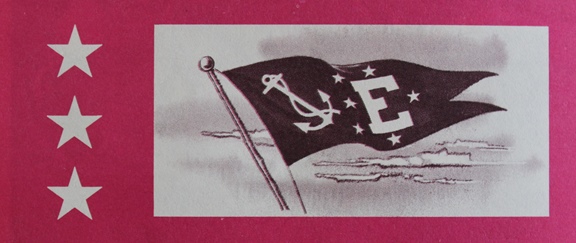
The Navy "E" flag with six stars.
Naval Five-Inch Gun Breech Housings for the
US Navy: The order to Fisher Body was originally made in
September 1940, and called for a production rate of 25 units per month.
In April 1941 the first shipment was made. From that point on, the Die
and Machine plant was always ahead of the Navy schedule, hence the
record number of Navy awards. In July 1943, 170 breech
housings per month were coming off the assembly line. A total of 6,342 housings were shipped during the conflict, with Fisher
Body Grand Rapids starting production in March 1944.
Naval skeptics did not believe that the
Die and Machine Plant could produce 25 units per month when its own
Naval Gun Factory could only turn out five per month. It seemed impossible
to the skeptics that Fisher Body could machine down an original 6,100
pound rough forging to a finished weight of 2,932 pounds, to which 217
other components had to be added. But the mass production
expertise of Fisher Body made it all possible.
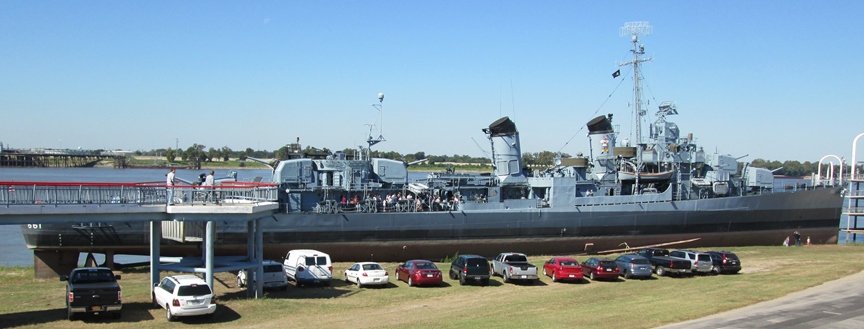
The main armament on US Navy destroyers
during WWII was the five inch, 38 caliber gun, for which the Die and
Machine plant supplied the majority of 6,342 breech housings made by
Fisher Body. The USS Kidd
on display in Baton Rouge, LA is armed with four 5 inch main guns.
Author's photo.
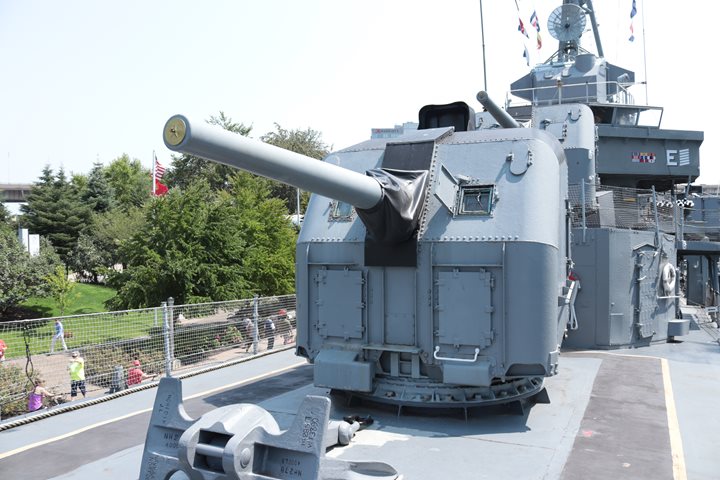
This five-inch, 38 caliber gun can be
seen at the USS Sullivans at the Buffalo and Erie County Naval and
Military Park in Buffalo, NY. Author's photo added 11-10-2017.
The five-inch 38 caliber naval gun was also
used on cruisers, battleships, and aircraft carriers. It could
either be used against other ships, for land bombardment, or for
anti-aircraft defense. It was the most versatile weapon used by
the US Navy during World War Two.
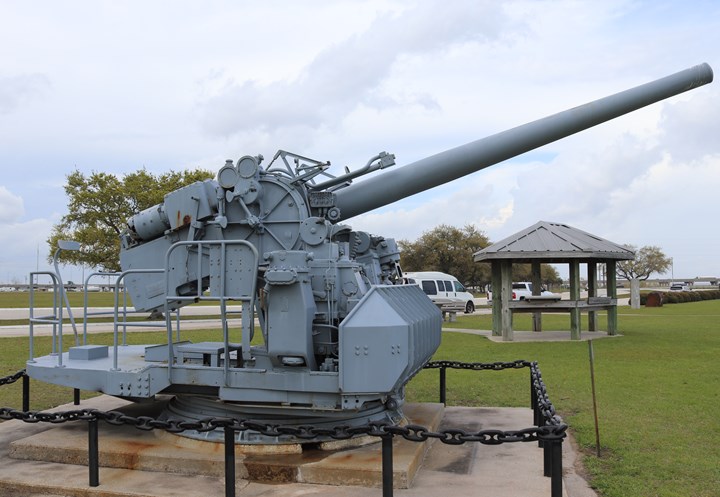
This is one of four five-inch, 38 caliber
guns on display at the USS Alabama in Mobile, AL. These do not
have the armored turret on them that were used on combat ships
for self protection. This allows for an excellent inspection of
the weapon. Author's photo added May 14, 2018.
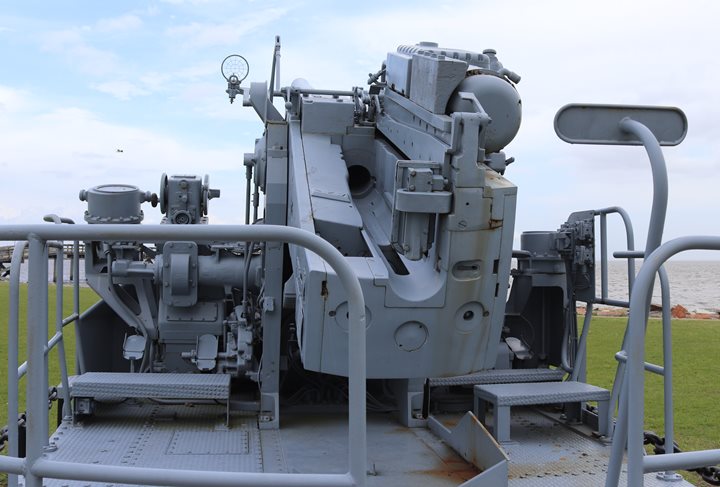
The gun mechanism was a complicated and
precision device consisting of 218 components. The Fisher Body
built breech housing weighed 2,932 pounds and is component in the center
of the gun mechanism with the opening for the five-inch round to which
the remaining 217 components were added. Author's photo added May
14, 2018.
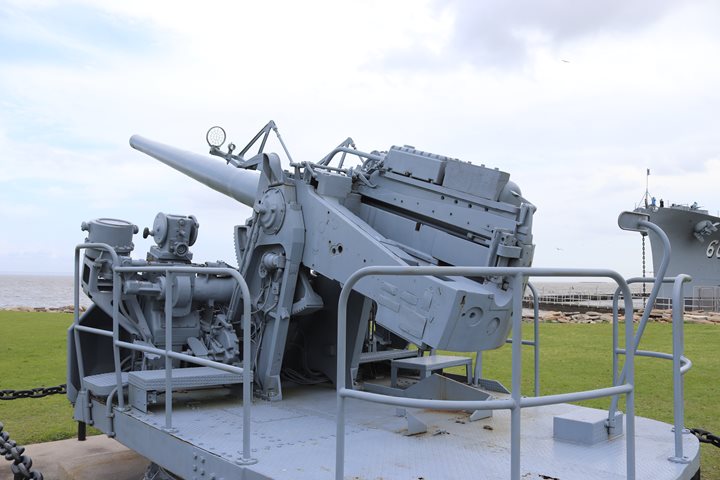
Author's photo added May 14, 2018.
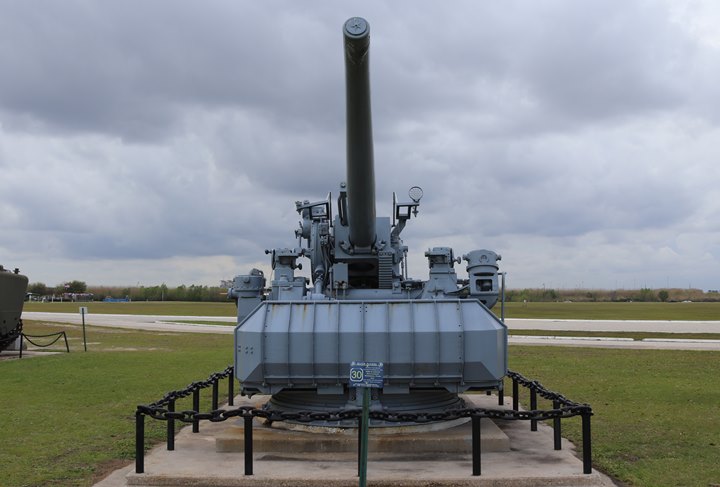
Author's photo added May 14, 2018.
Naval Three-Inch Gun Breech Housings for
the US Navy: The Die and Machine Plant also produced 9,459
three-inch naval breech housings starting in April of 1942, at a rate of
100 per month. This run rate was achieved four months ahead of
schedule and one month before the first one was contracted to be shipped!
The three-inch guns were used on 2,710 Liberty ships, 534 Victory ships,
1,050 LSTs, 97 Evarts Class Destroyer Escorts, 105 Buckley Class
Destroyer Escorts, and 72 Cannon Class Destroyer Escorts. The three-inch gun was also used on
various types of merchant shipping during the war.
The Mark 2 three-inch/50 caliber gun was
served by a seven man crew, and had a muzzle velocity of 2,100 feet per
second. It had a maximum range of 14,000 yards against surface
targets and could reach 30,000 feet when used against aircraft. With a well
trained crew, it could fire 18 rounds per minute.
The USS Slater DE-766: I was able
to visit the USS Slater in August of 2017. This is the best ship's
tour I have been on! The guided tour of the top side of the ship
was most informative. Beside finding the Fisher Body three-inch gun
breech, I was also found a GM Pontiac Division 20mm Orelikon on the
tour. I then paid for the engine room tour to view the seven GM
Cleveland Diesel engines onboard. Also found in the engine room
were two GM Harrison Radiator heat exchangers.
I highly recommend anyone interested in WWII,
or naval history to visit this excellently preserved ship. It is
the most complete of the WWII ships I have visited.
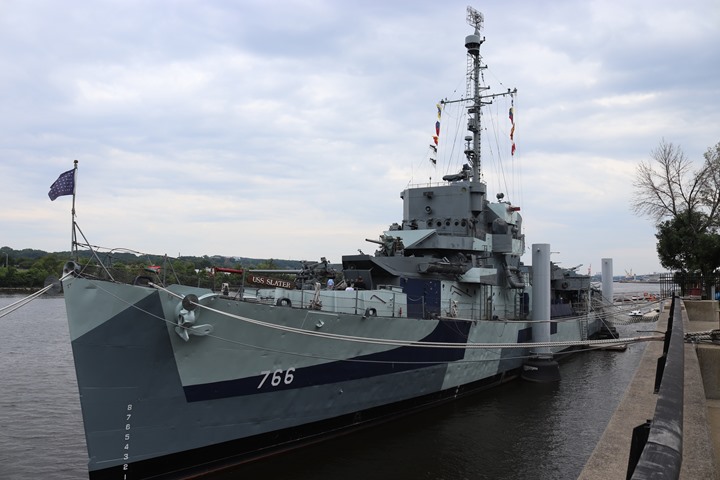
The Number 1 three-inch/50 on the USS Slater
DE-766 has a Fisher Body built breech. The USS Slater is on
display along the Hudson River water front in Albany. It is the
only Cannon Class Destroyer Escort on display in the world.
Author's photo added 8-25-2017.
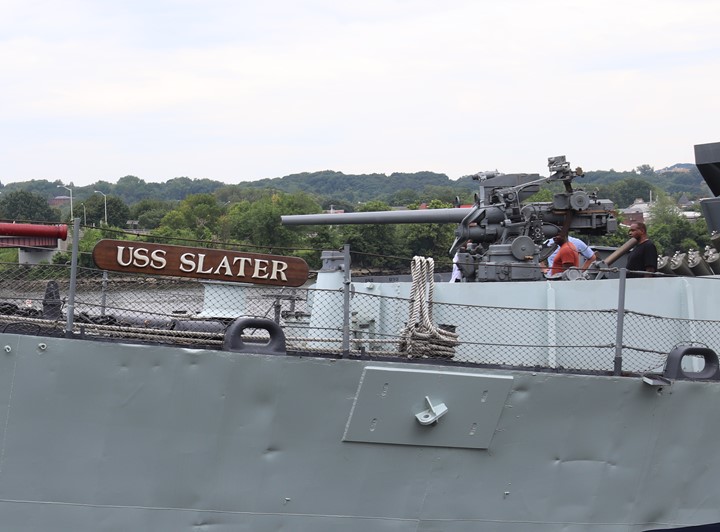
Author's photo added 8-25-2017.
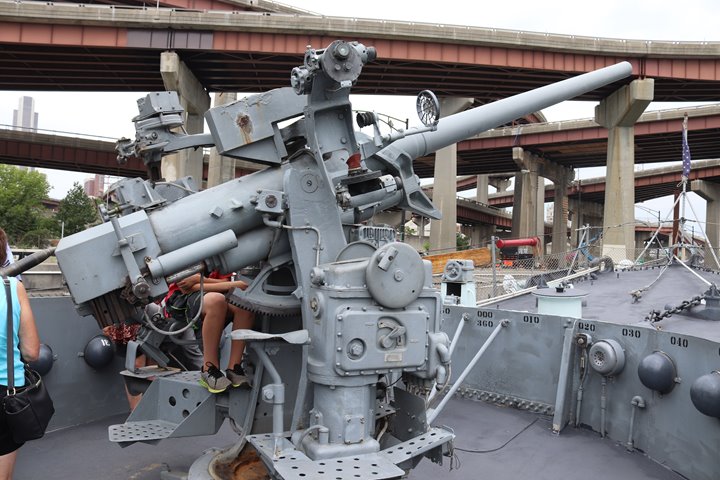
The tour guide encouraged those on the tour
to get on the gun mount and operate the elevation and transverse
controls. Author's photo added 8-25-2017.
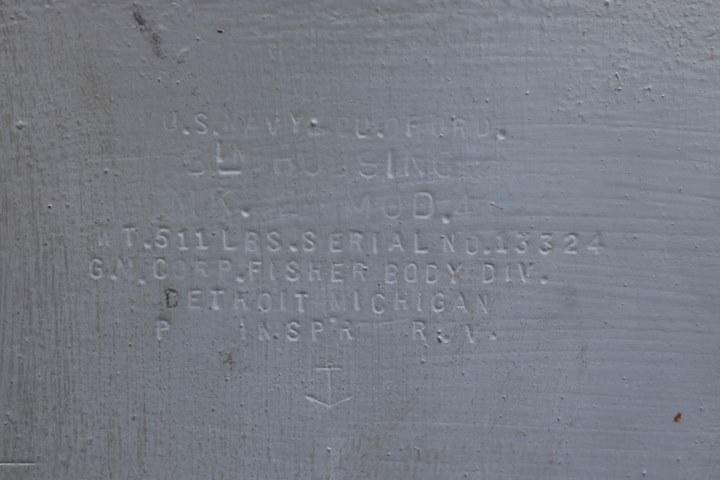
This is Fisher Body three-inch breech serial
number 13324. Author's photo added 8-25-2017.
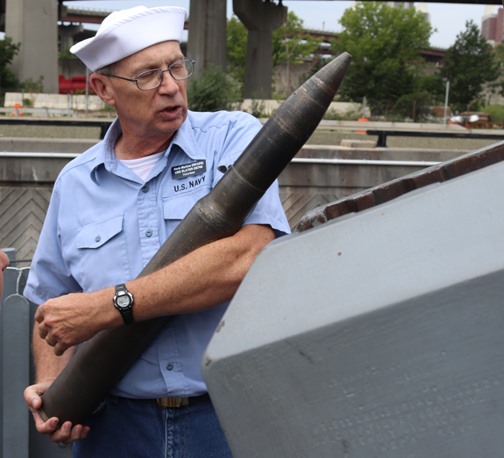
The tour guide showed the size of the three-inch round to my tour group. Author's photo added 8-25-2017
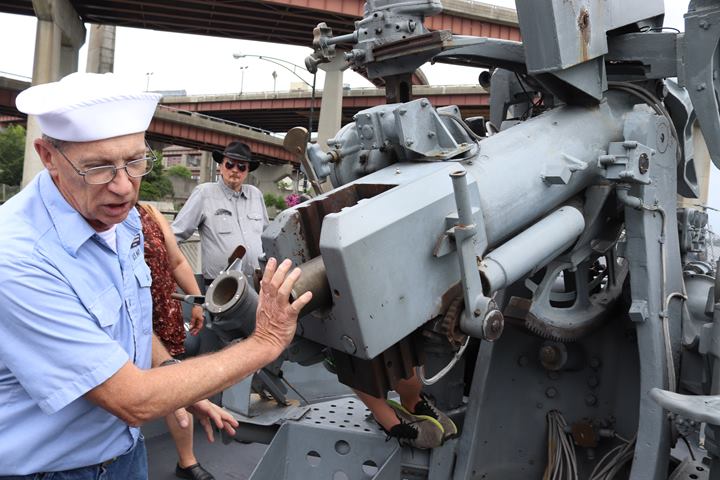
Author's photo added 8-25-2017.
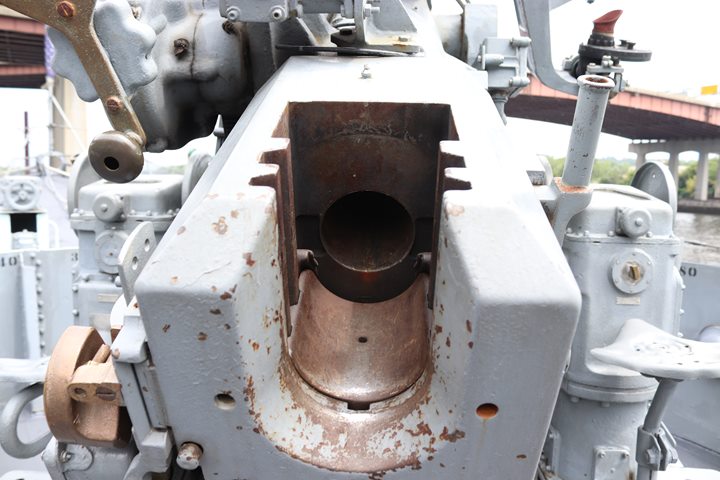
Author's photo added 8-25-2017.
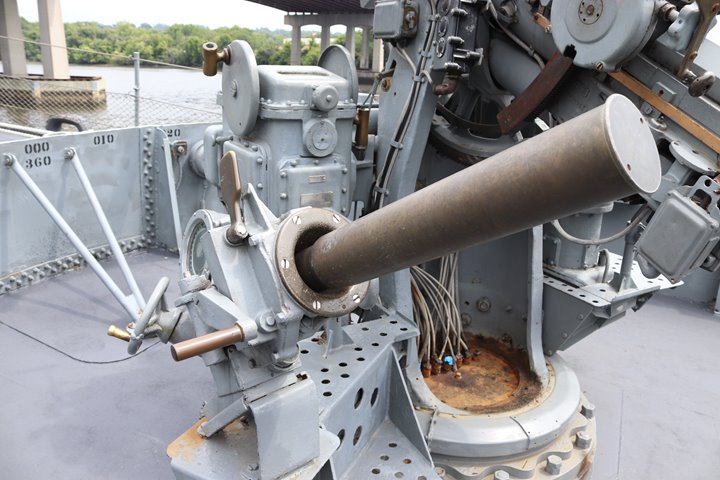
This is one of the few three-inch guns I
have seen that has the range setting device on it. By inserting
the round into the device, the crew could then use the hand crank to set
the range for anti-aircraft fire. Author's photo added 8-25-2017.
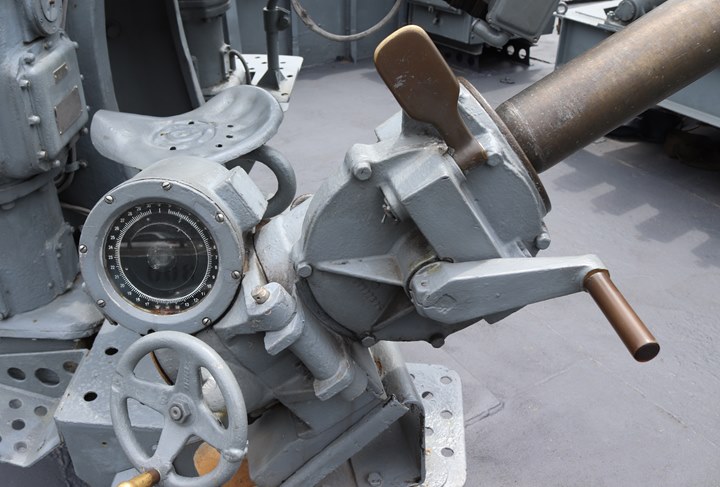
Author's photo added 8-25-2017.
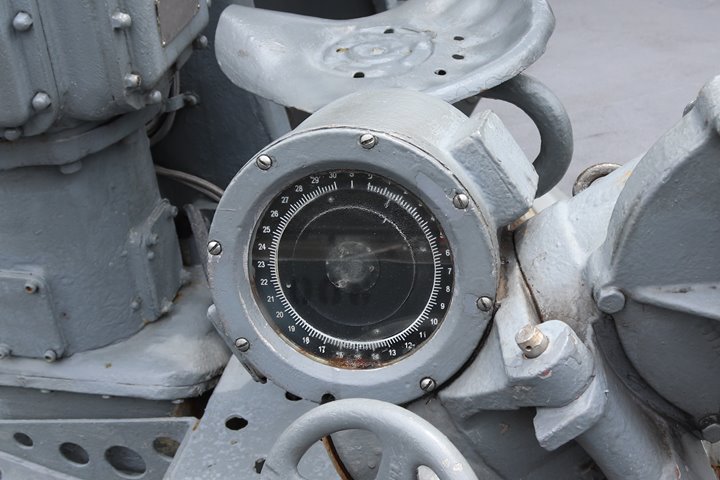
The ranger finder's scale runs from 0 to 30
which was 0 to 30,000 feet in altitude when the three-inch gun was used as
an anti-aircraft weapon. Its maximum range for a surface target
was 14,000 yards. Author's photo added 8-25-2017.
LST-393:
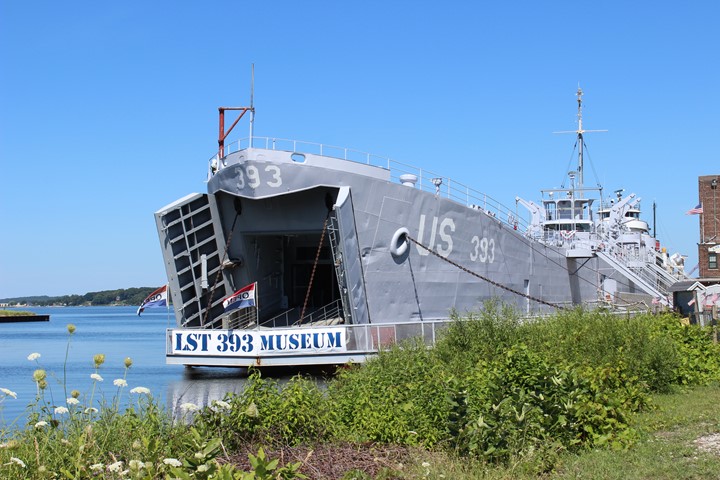
The LST-393 located at Muskegon, MI, is
one of only two LSTs (Landing Ship, Tank) on display in the United States. The LST is identifiable by its bow doors, which allowed it to
unload vehicles and troops directly to an invasion beach. A total
of 1,051 were built during WWII. LST-393 is 328 feet long and is
50 feet wide, and was designed to deliver tanks and other vehicles
directly to an invasion beachhead. Author's photo added 8-17-2016.
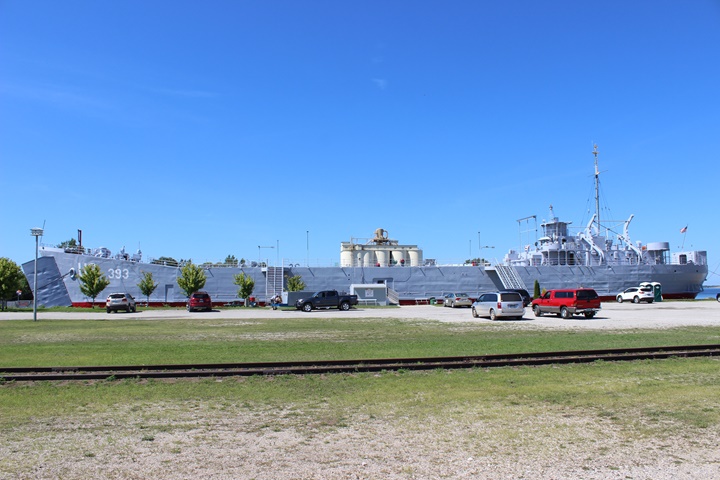
LST-393 was launched on November 11, 1942 in
Newport News, VA and saw service at Sicily, Salerno, and Omaha Beach in
Normandy. Sicily was the first utilization of the LST in combat.
LST-393 delivered 3,248 vehicles and over 9,000 soldiers during WWII.
Many of the vehicles and troops were landed during the 30 round trips
LST-393 made to Normandy. It also returned to England 10,000
wounded troops and 5,000 German POWs.
The LST was one of the most important weapons
in WWII. The Normandy Invasion was originally scheduled May 1, 1944. General Eisenhower delayed the operation one
month until June in order to obtain a few more LSTs for the landings.
Because the invading forces had no ports in Normandy to unload heavy
equipment and supplies, much of it would have to be unloaded out of the
open bow doors of LSTs on the beach. A total of 245 LSTs
were used at Normandy, still five short of the 250 originally planned.
But the invasion of Europe could wait no longer. Author's photo
added 8-17-2016.
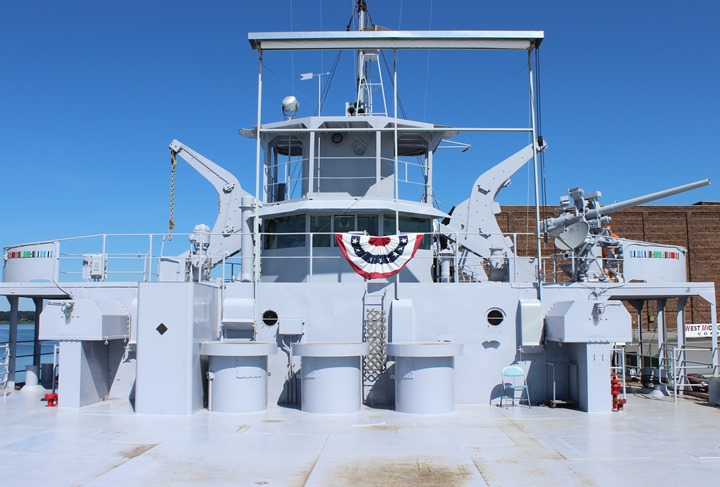
On the port side gun position is a three-inch naval gun with a Detroit Tool and Machine Plant breech.
Author's photo added 8-17-2016.

In normal practice during WWII, the three-inch/50 caliber gun would be mounted on the fantail gun tub at the rear
of the LST. Since LST-393 was used as a car ferry on Lake Michigan
from 1946 until 1973, the ship was highly modified
from its original configuration, and currently does not have a fantail
gun tub. The current owner, the USS LST-393 Preservation
Association, took ownership of the LST in 2005 and has been working
diligently to restore the ship to original configuration. Author's
photo added 8-17-2016.
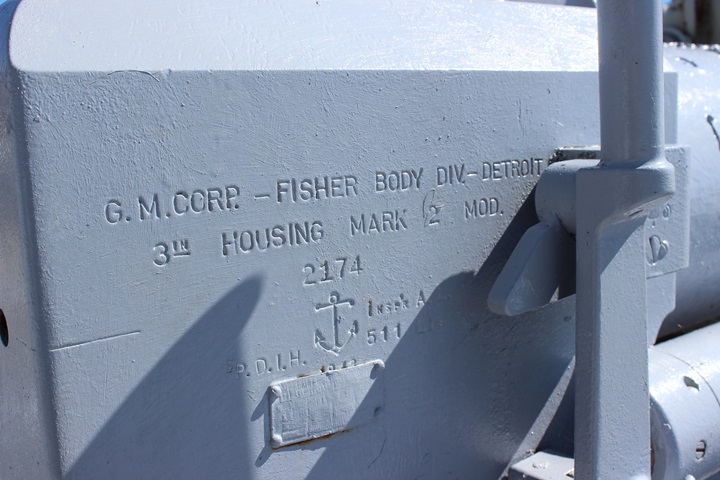
This is serial number 2174. Author's
photo added 8-17-2016.
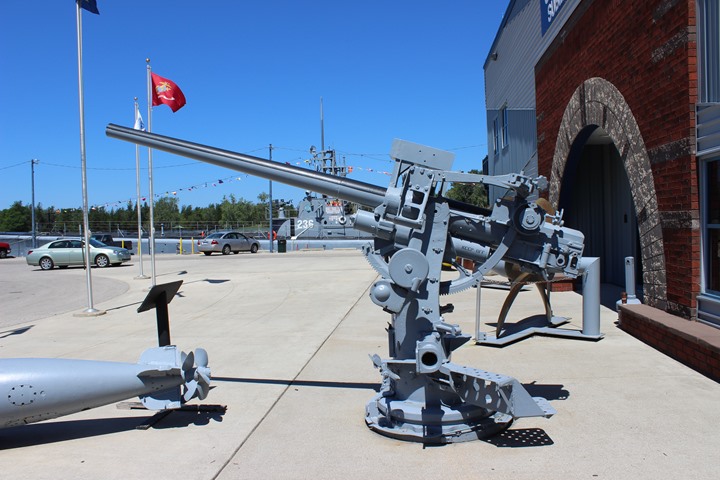
Just a few miles away from LST-393 another three-inch naval gun
with a Fisher Body Detroit Die and Machine Plant made breech is on
display in front of the USS Silversides Museum. The submarine USS Silversides is visible in the
background. Author's photo added 8-17-2016.
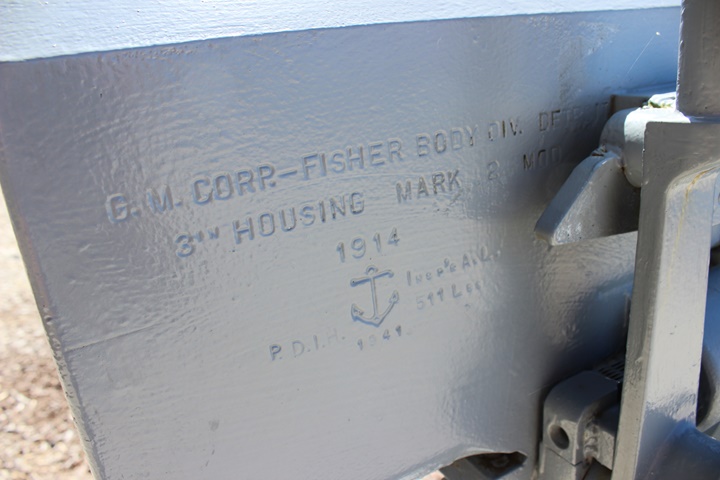
This is serial number 1914. Author's
photo added 8-17-2016.
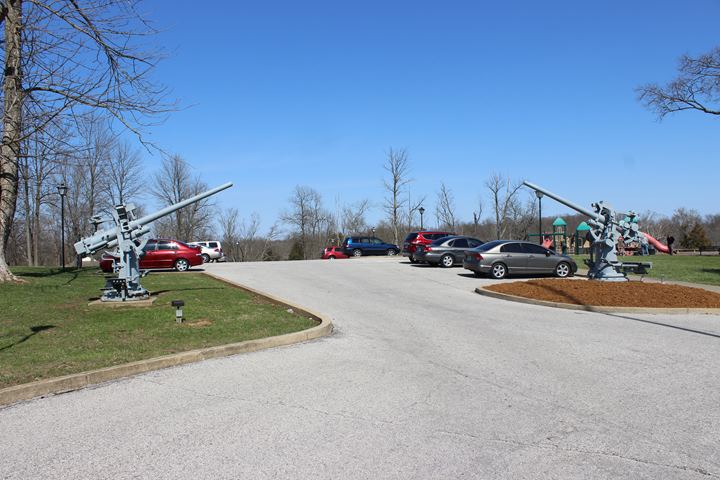
Guarding the entrance to the parking lot of
the Jeffersontown, KY Veterans Memorial Park are two three-inch naval
guns with Fisher Body Detroit Die and Machine Plant built breeches.
The weapon on the left, or west side of the entrance, is serial number
4803, and the one on the east side is serial number 2085 Author's
photo added 3-10-2017.
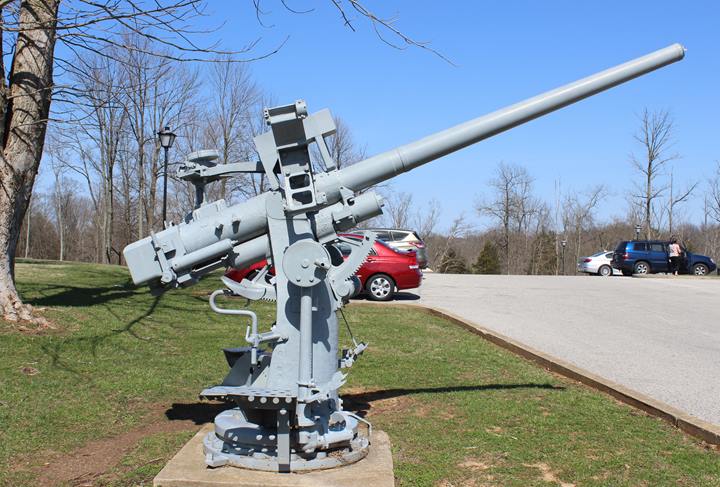
Serial number 4803. Author's photo
added 3-10-2017.
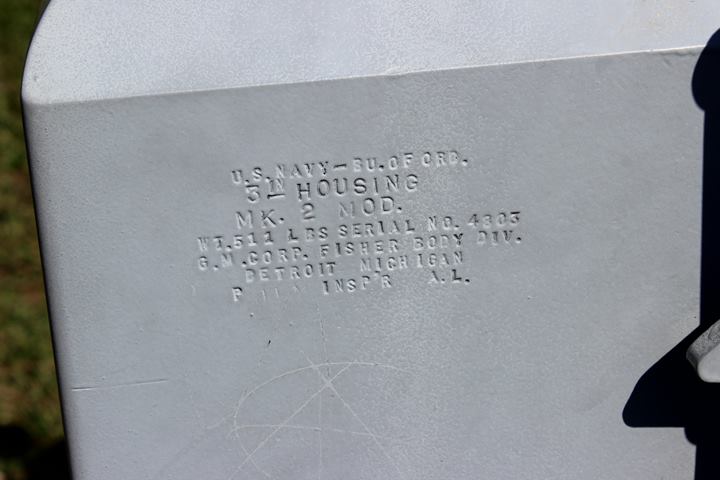
Serial number 4803. Author's photo
added 3-10-2017.
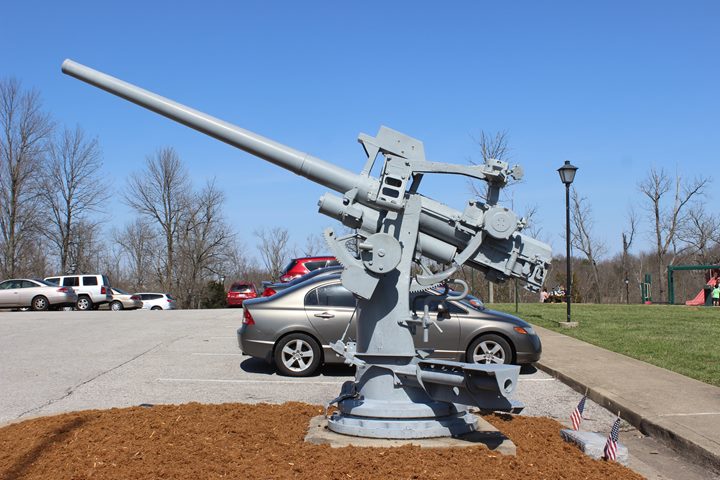
Serial number 2085. Author's photo
added 3-10-2017.
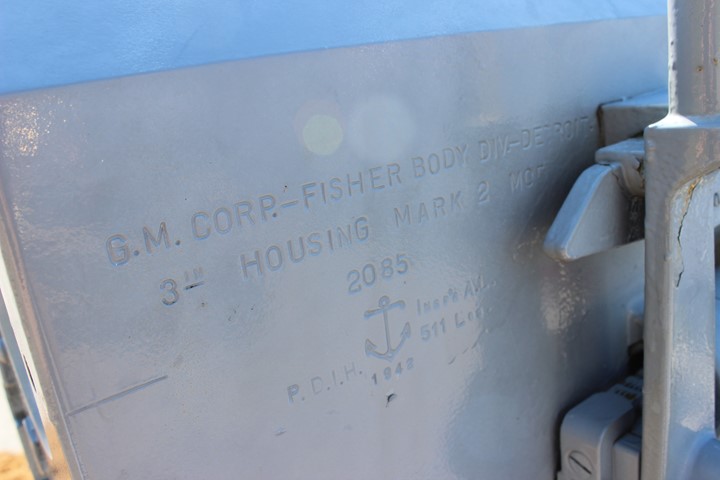
Serial number 2085 was manufactured in 1942.
Author's photo added 3-10-2017.
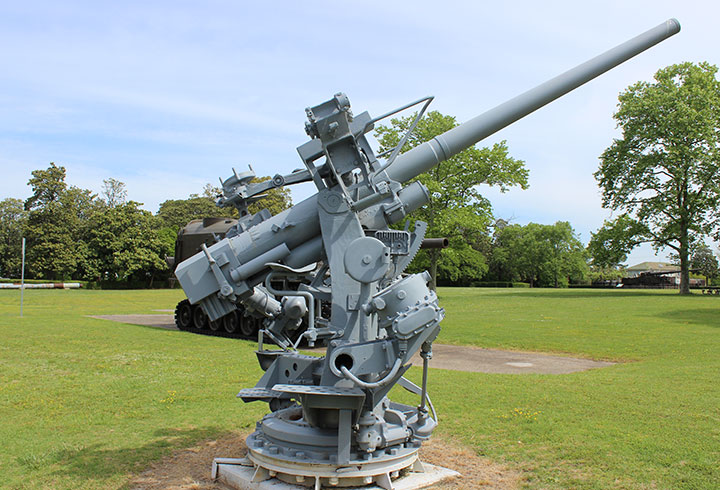
Shown here is a three-inch naval gun with a
Fisher Body Die and Machine Plant breech, as seen at the Virginia War
Museum. Author's photo.
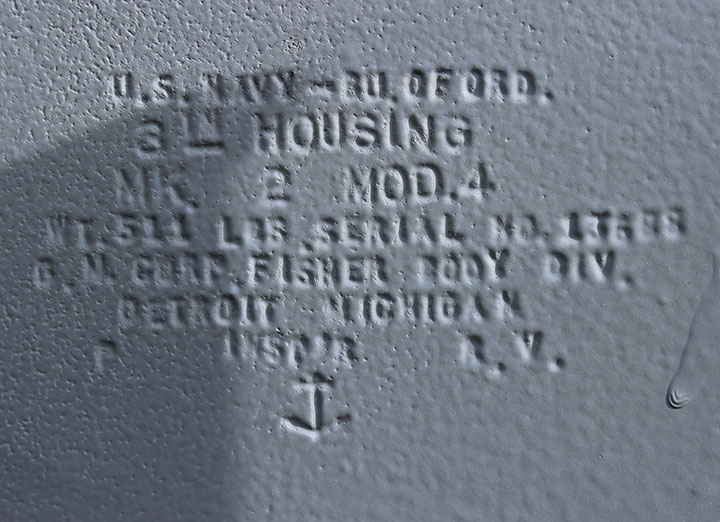
This shows it weighs 511 lbs. and is serial number 13686. Author's
photo.
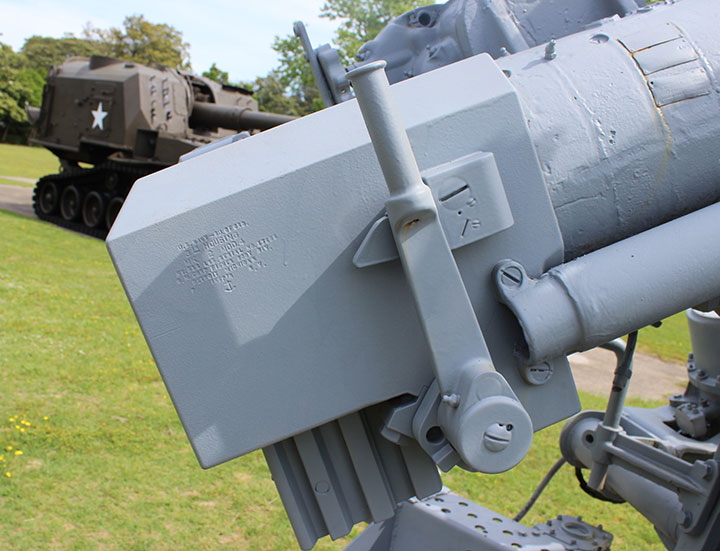
Author's photo.
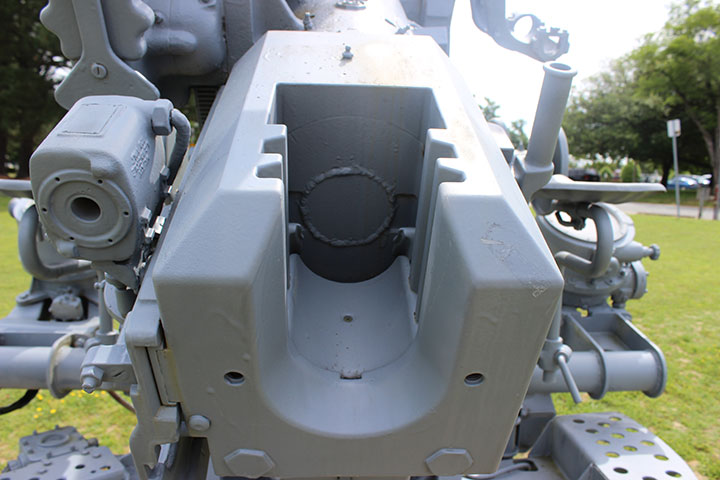
Author's photo.
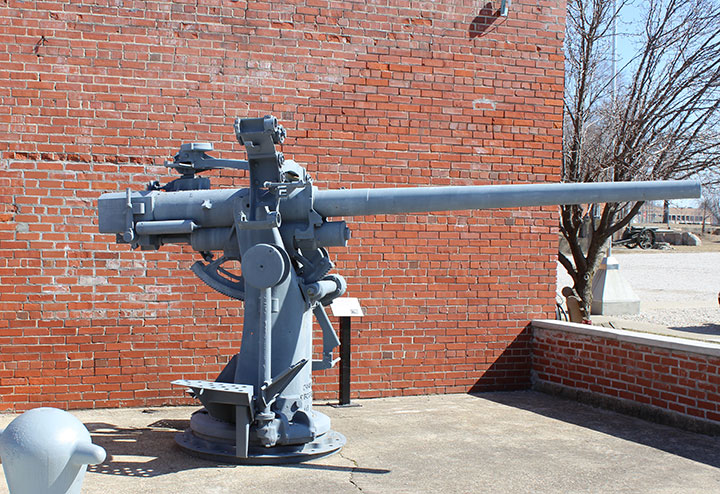
This particular three-inch Naval gun with a
Die and Machine Plant breech housing is on display at the Indiana
Military Museum in Vincennes, IN. Author's photo.
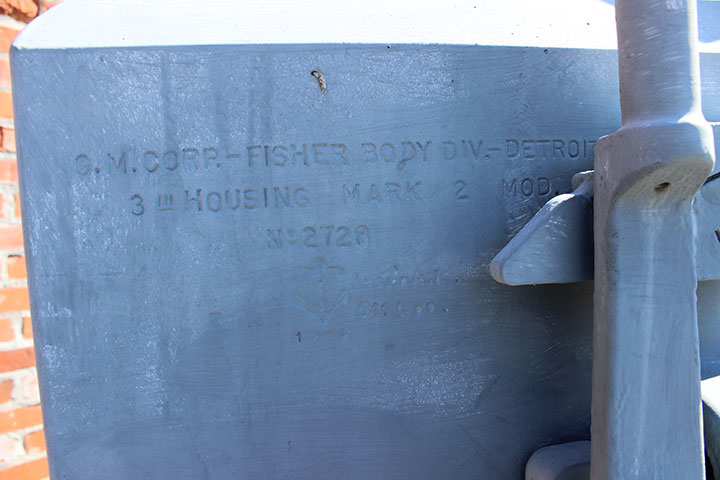
The serial number on the housing is 2728.
Author's photo.
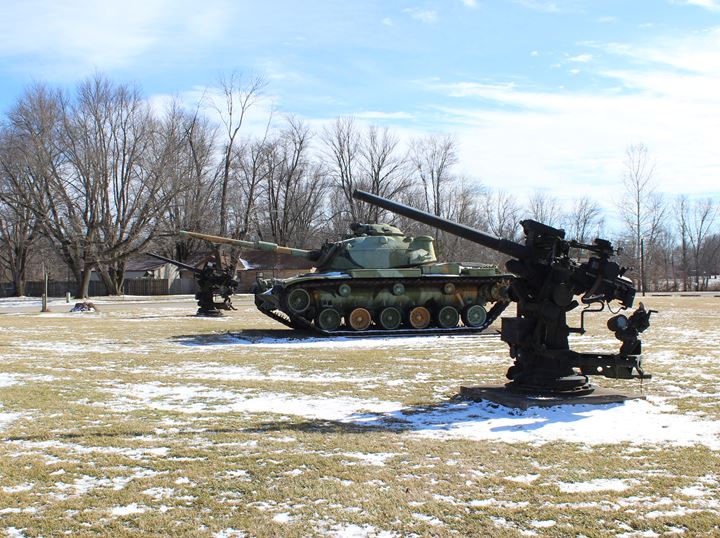
Two three inch-naval guns with Fisher Body
breech assemblies flank an M60 tank at the American Legion in Shelburn,
IN. Author's photo.
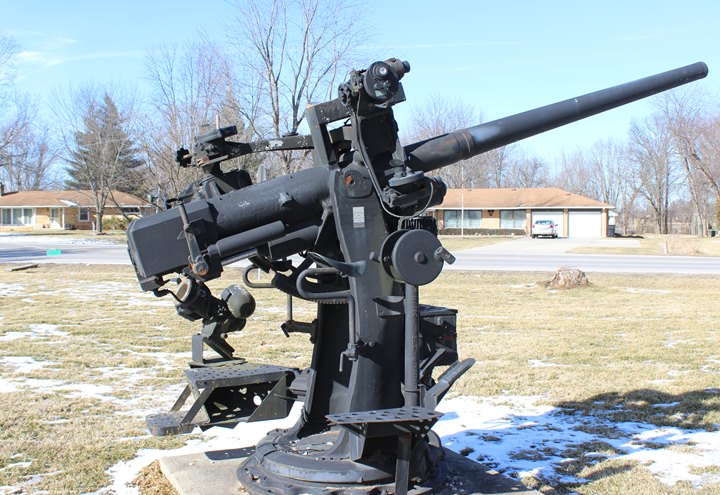
Author's photo.
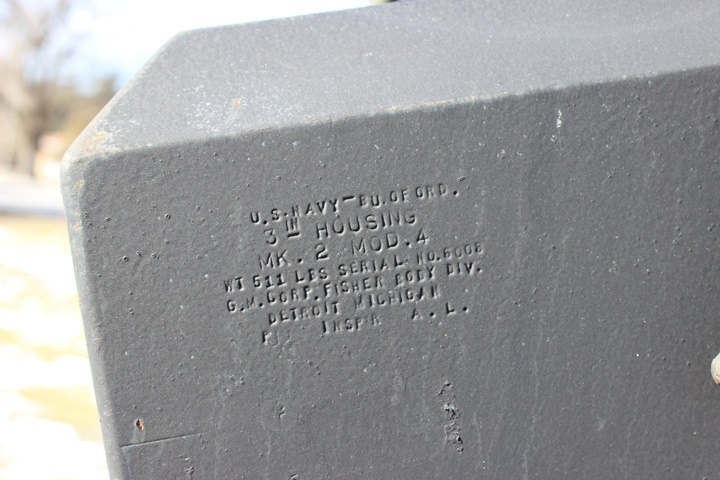
This one is serial number 6008 and also
weighs 511 pounds. Author's photo.
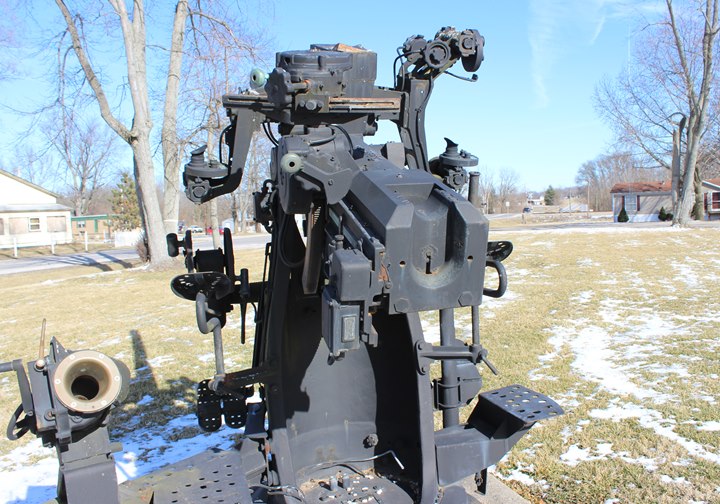
Author's photo.
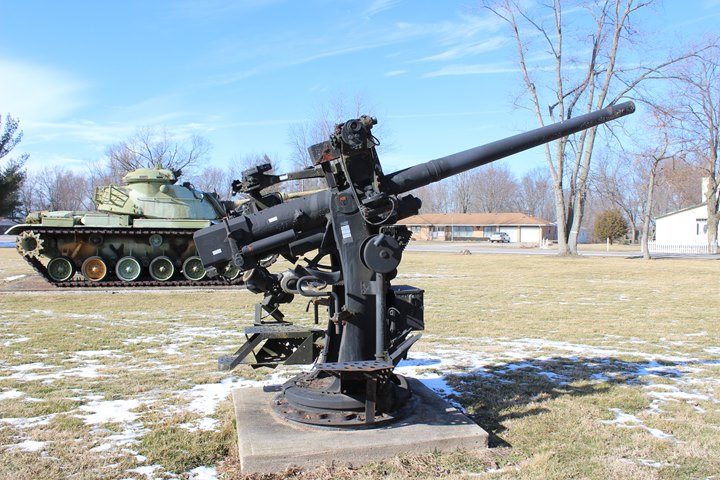
This is the weapon on the opposite side of
the M60 in the first photo. Author's photo.
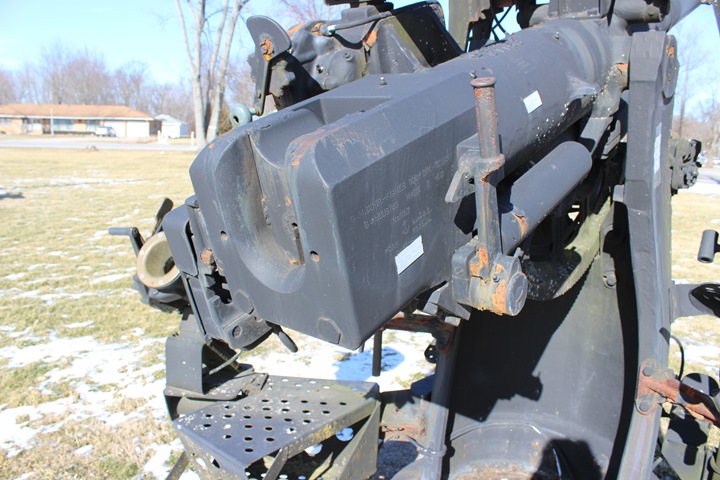
Author's photo.
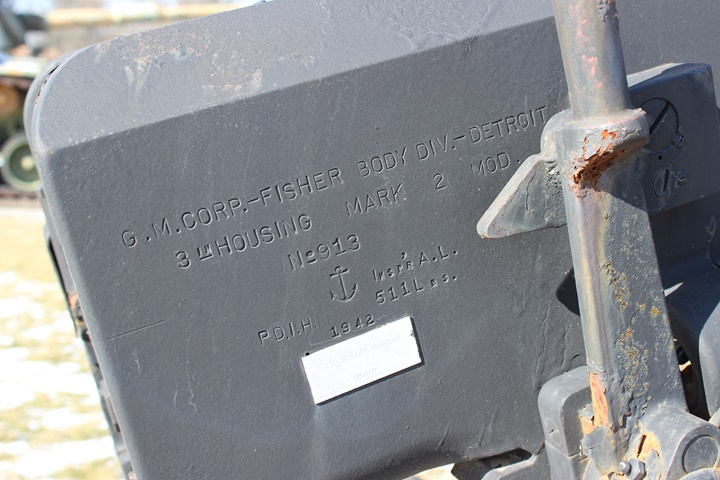
This three inch-gun produced by Fisher Body
Die and Machine is serial number 913, made in 1942.
Author's photo.
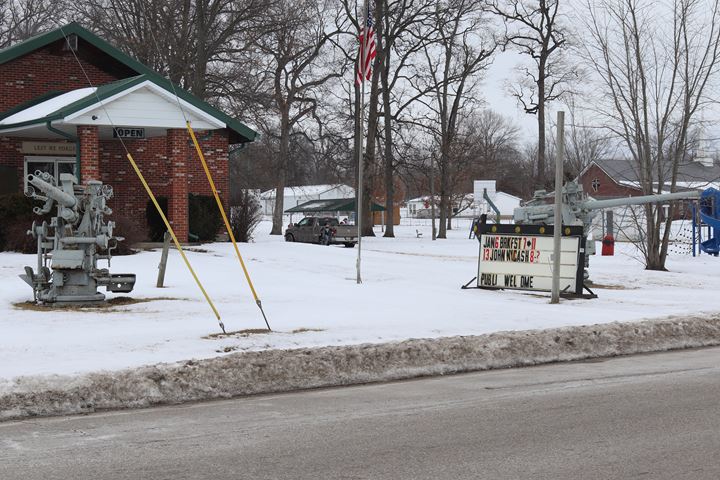
Two three-inch naval guns with Fisher Body breech assemblies are located
on the front lawn at the American Legion Post 479 in Lyons,
IN. Author's photo added 1-29-2018.
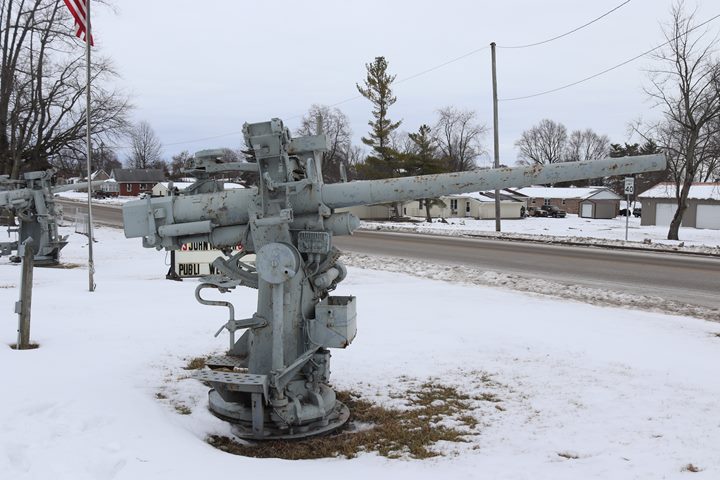
This three-inch gun produced by Fisher Body
Die and Machine is serial number 2489.
Author's photo added 1-29-2018.
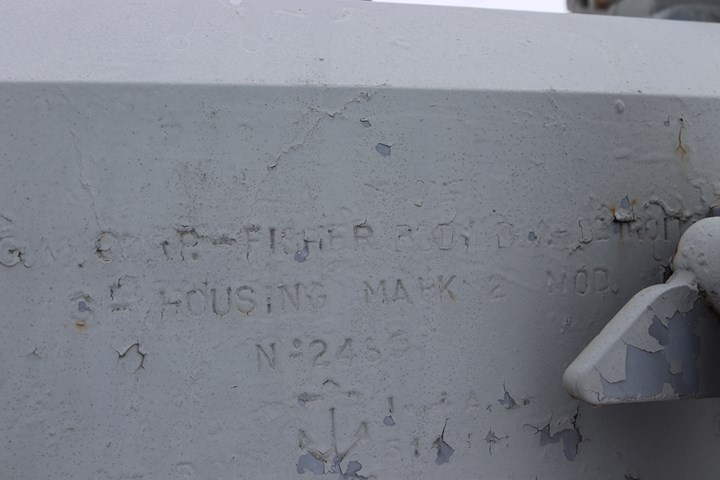
Author's photo added 1-29-2018.
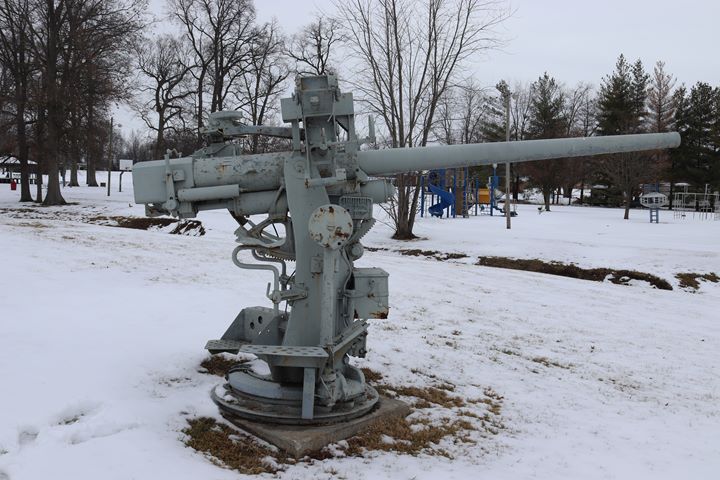
The second three-inch gun was produced by Fisher Body
Die and Machine and is serial number 2147, made in 1942.
Author's photo added 1-29-2018.
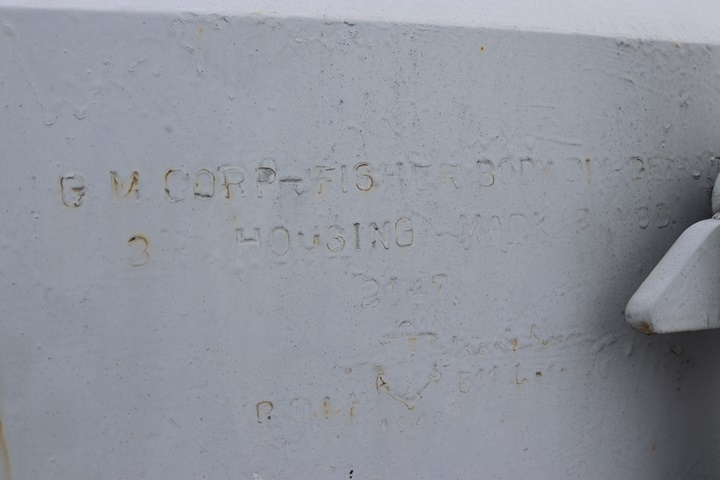
Author's photo added 1-29-2018.
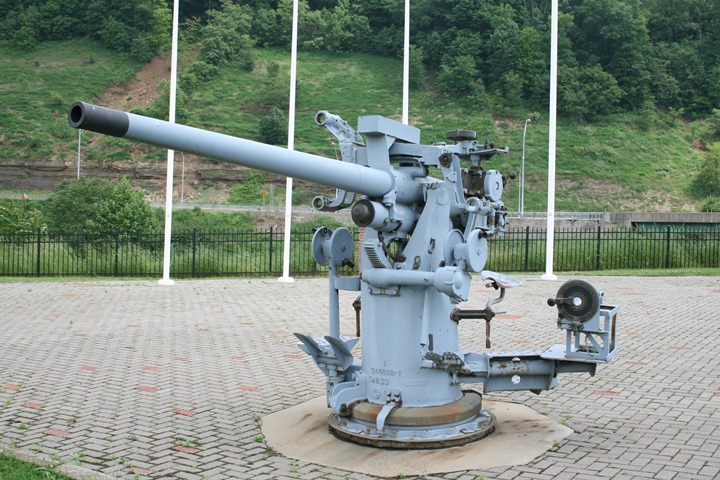
This three-inch gun at the Brooke County
Veteran's Memorial Park in Weirton, WV has a Fisher Body breech assembly
serial number 5034. Author's photo added 2-12-2022.
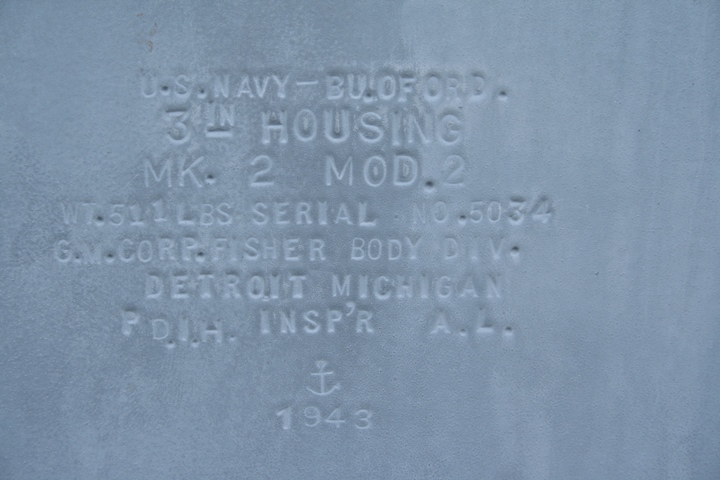
Author's photo added 2-12-2022.
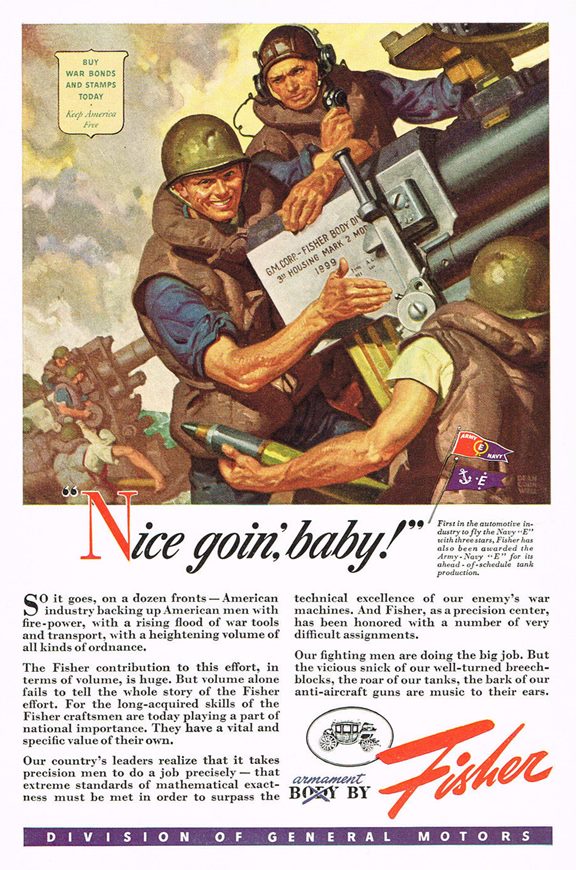
This ad shows the prominently marked Fisher
Body three-inch breech in action.
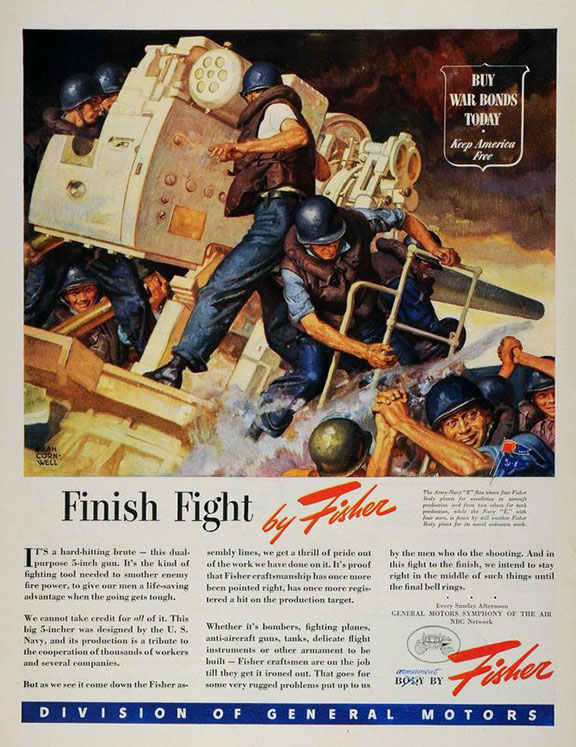
This ad shows the larger five-inch 38
caliber gun Fisher Body
breech housing.
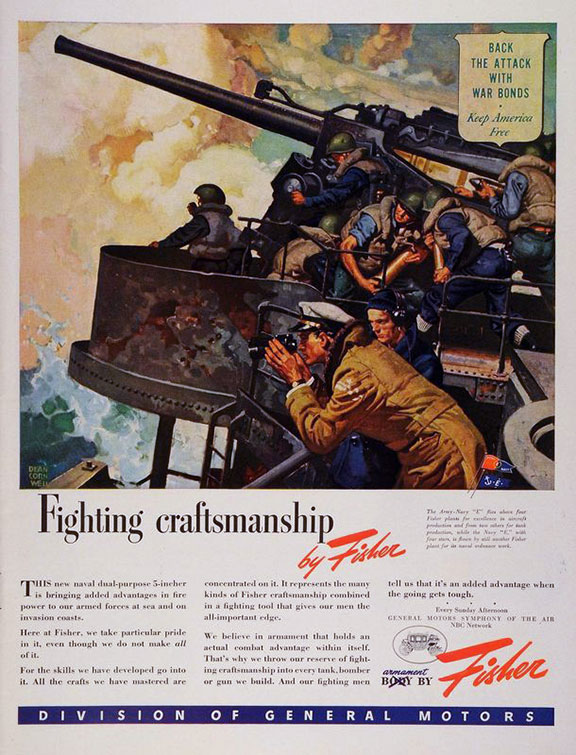
The Fisher Body Die and Machine Plant was a
busy place during World War Two. Besides making nearly 15,000
naval gun breech housings, it made tooling for Army aircraft, parts
for tanks, diesel engines and Torqmatic transmissions.
Aircraft tooling and fixtures:
B-25, B-29, P-80
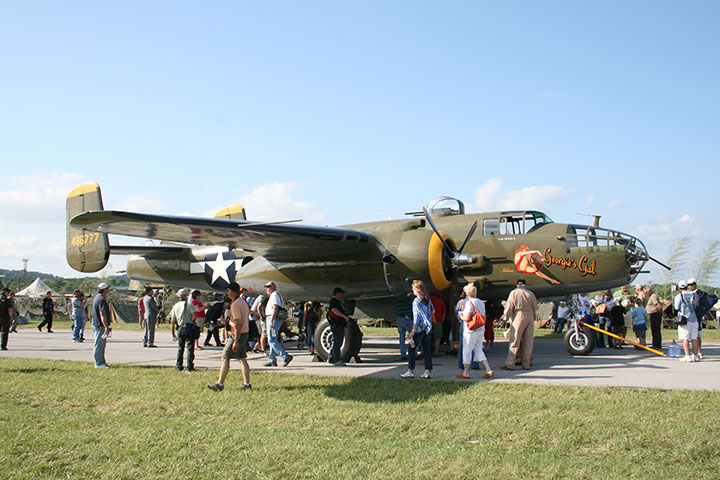
Tooling and fixtures for the North American
B-25 went to many Fisher Body plants, with Memphis being the main
producer of B-25 structural components for the division. Author's
photo.
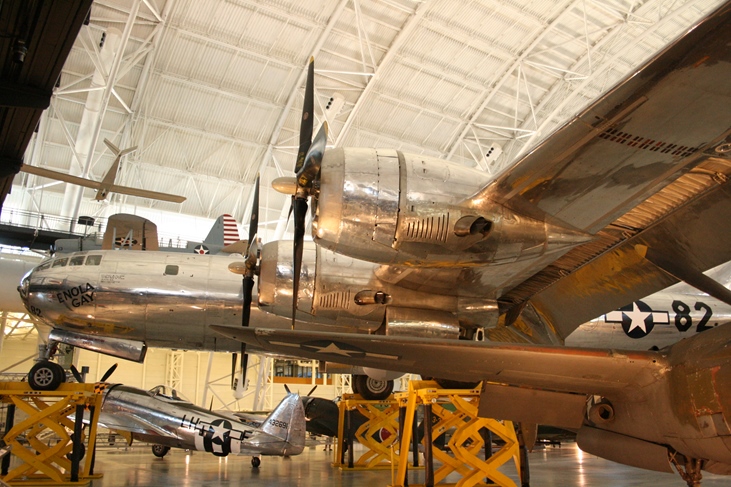
Fisher Body supplied several components to
the Martin B-29 assembly plant in Omaha, NE. The most famous B-29
to come off the assembly line at Omaha was the "Enola Gay."
The Die and Machine plant supplied tooling and fixtures that made
components used in the "Enola Gay." Author's photo.

At the end of World War Two the US Air Force
was starting to tool up for the production of the new Lockheed P-80
Shooting Star. The Die and Machine Division of Fisher Body was
contracted to make tooling for the engine intakes and wing tips.
Some sources indicate Fisher Body built or was going to build the entire
aircraft. This is incorrect. In any event, the tooling was
not finished when the war ended. Author's
photo added 2-21-2018.

The wing tip on the P-80. Author's
photo added 2-21-2018.

The left air intake on the P-80. Author's
photo added 2-21-2018.
M4, M10, M36, M26, M18 tank and tank
destroyer parts: Fisher Body in Grand Blanc, MI had a tank
arsenal that built M4A2 and M4A3 Sherman tanks, the M10 and M36
Wolverine tank destroyers, and the M26 Pershing heavy tank. The
Die and Machine Plant in Detroit, MI supported this production with
parts for these vehicles along with the Buick assembled M18 Hellcat.
However, Grand Blanc was the main supplier of hulls and turrets for the
M18, and no doubt the Die and Machine plant supplied components for
their construction. Fisher Body supplied the majority of the
turret assemblies for the M36 Jackson. The Die and Machine plant
supplied components for the M36 turret which was assembled at the Grand
Blanc plant.
The Fisher Body Die and Machine Plant in
Detroit supplied parts for the type tanks and tank destroyer show below.
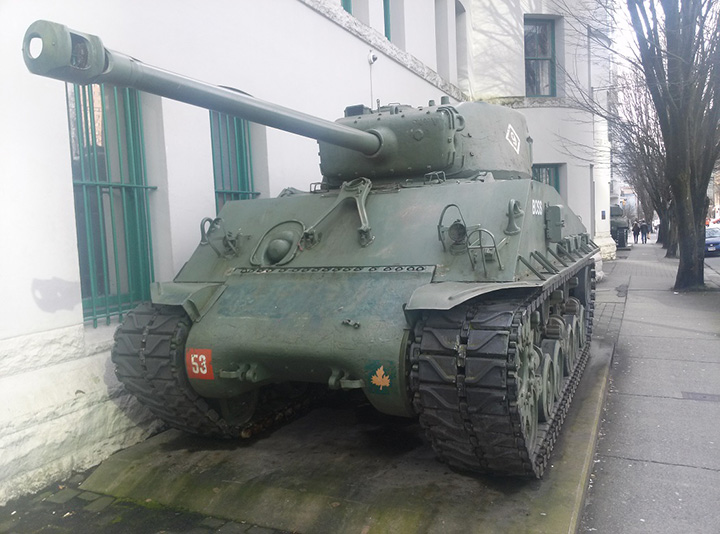
This M4A2(76)HVSS is Grand Blanc serial
number 69192 and registration number 30129671, built in April
1945. It can be seen outside the Beatty Street Drill Hall in
Vancouver, BC. It was one of 7,508 M4A2s built in the plant. Photo courtesy of David Jackson, Jr.
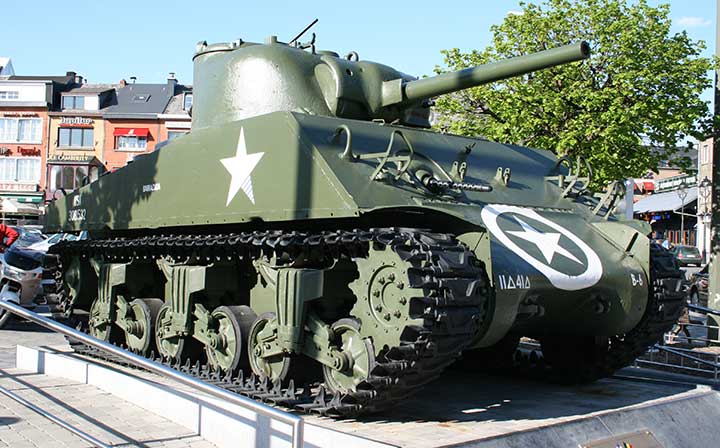
Of all of the Sherman tanks built during WWII, it is
noteworthy that one built by Fisher Body in Grand Blanc, MI in March of
1944 has the honor of representing all of the M4s that participated in
the Battle of the Bulge. Registration Number 3081532 was one
of 339 M4A3 Sherman tanks built in the Fisher Body Tank Arsenal in Grand
Blanc, MI in March 1944. Author's photo.
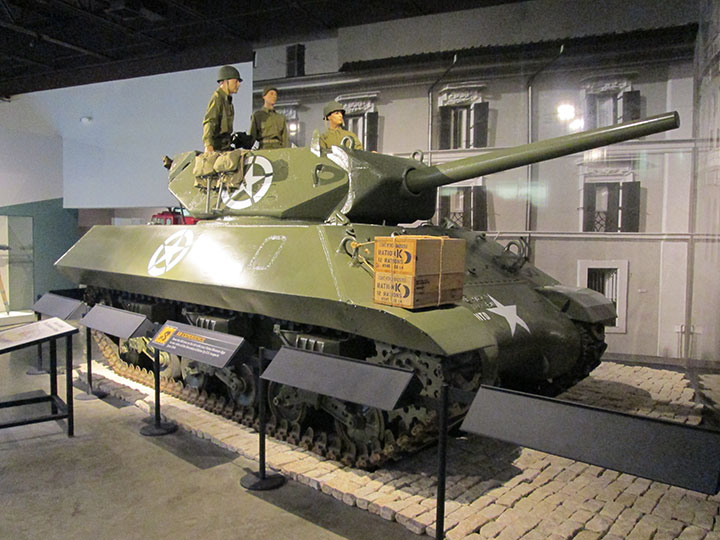
This is one of 5,368 M10 Tank
Destroyers built at Grand Blanc, MI. This late model, with no
attachment "knobs" welded on the hull and turret for added armor plate, is located at the
General George Patton Museum at Fort Knox, KY. Author's Photo.
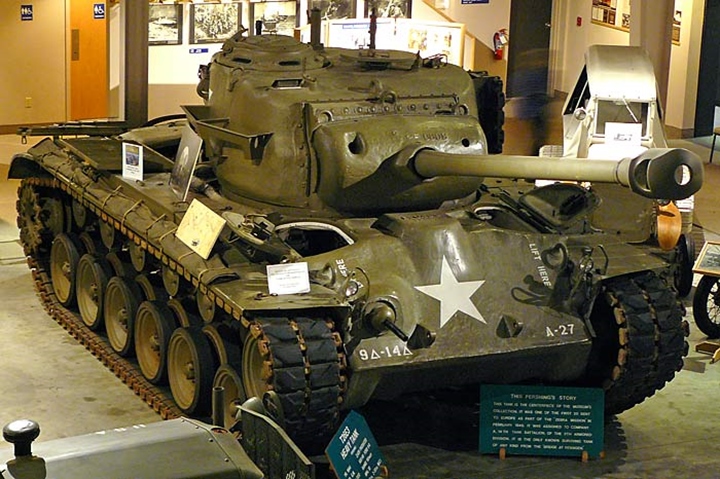
A rare national treasure!!! This
Fisher Body T26E3 built in Grand Blanc, MI was one of the five Pershings
at the Remagen Bridge. It is on display at the Wright Museum of World
War II in Wolfeboro, NH. This excellent photograph was provided by
Bill Malone.
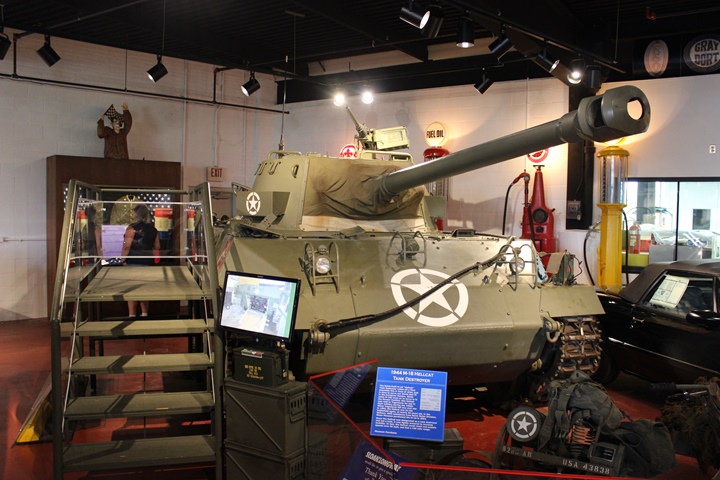
This M18 Hellcat is on display at the Buick
Museum in Flint, MI, only a mile or two from where it was assembled.
Author's Photo.
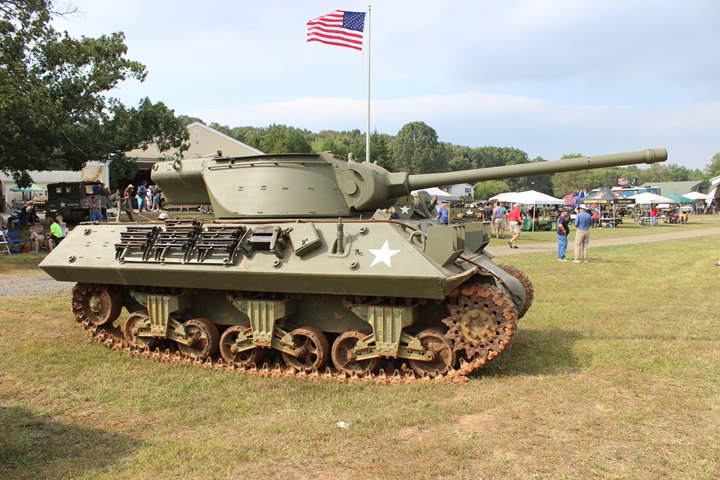
An M36 Jackson. The M36 was
built on the chassis of the Ford M10A1 Wolverine. Fisher Body
supplied the turrets to companies contracted with the conversions.
Author's photo added 12-27-2016.
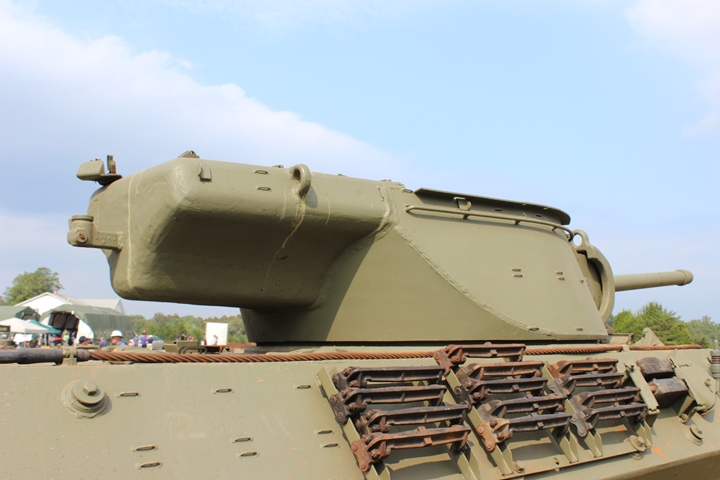
The Fisher Body built turret.
Author's photo added 12-27-2016.
155mm and 8 inch Gun parts, Diesel Engine
parts and Torqmatic Transmission parts: The Die and Machine
plant was well diversified in the parts it built and the products or
weapons in which they were utilized.
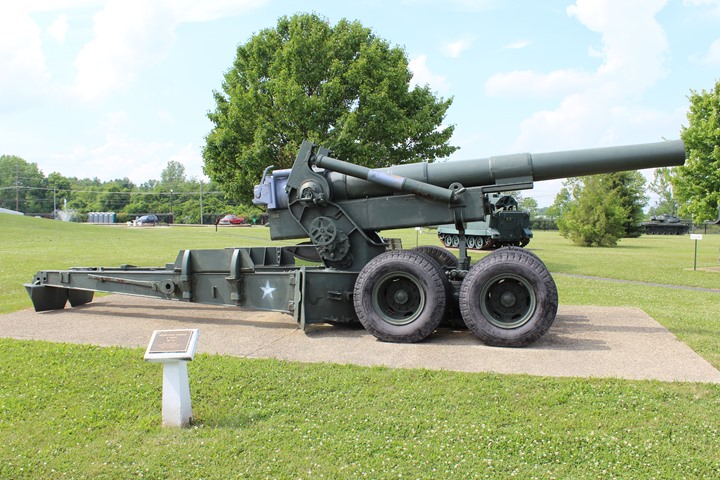
Seen here is an M115 8 inch howitzer at the
Camp Atterbury outside museum in Edinburgh, IN. Author's Photo.
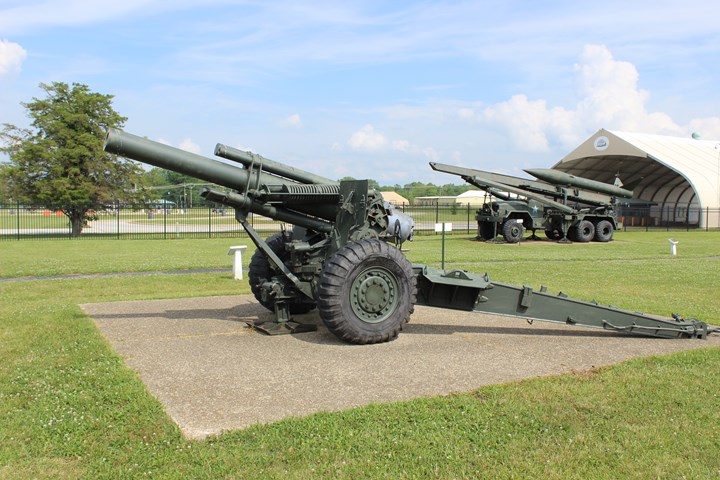
This M114 155mm howitzer is also at
the museum.
In the background is a 1950's era Honest John missile and mobile
launcher.
Author's photo.
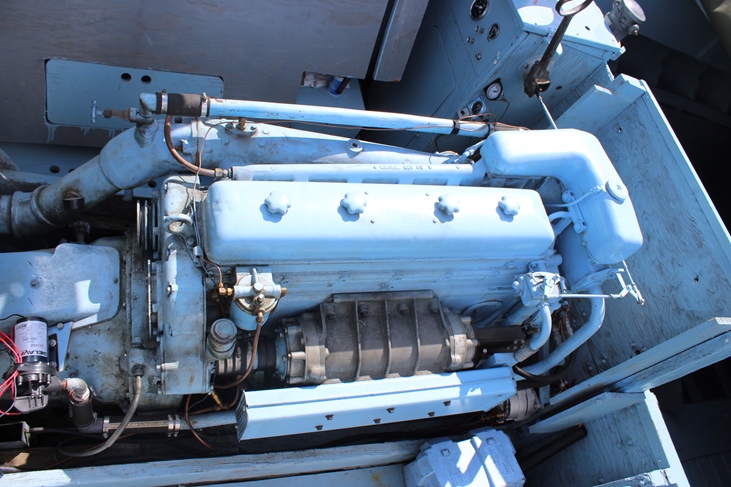
The Detroit Diesel Division of General
Motors built 193,000 diesel engines for many applications, including
this one photographed in the engine bay of an LCVP landing craft.
Author's photo.
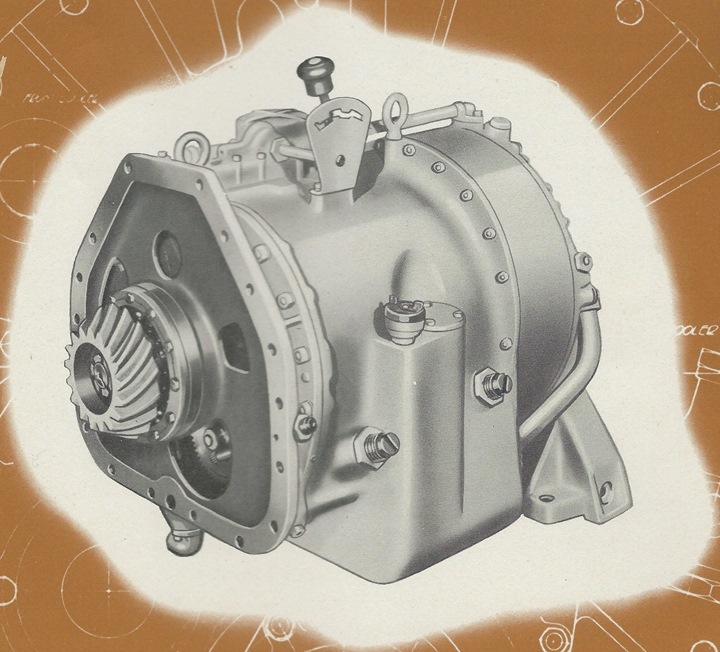
The Detroit Transmission Division of GM
built the 950-T Torqmatic transmission used in the Buick M18 Hellcat
tank destroyer. It also built the Torqmatic transmission for the
M26 Pershing built by both the Fisher Grand Blanc and Chrysler Tank
Arsenals.
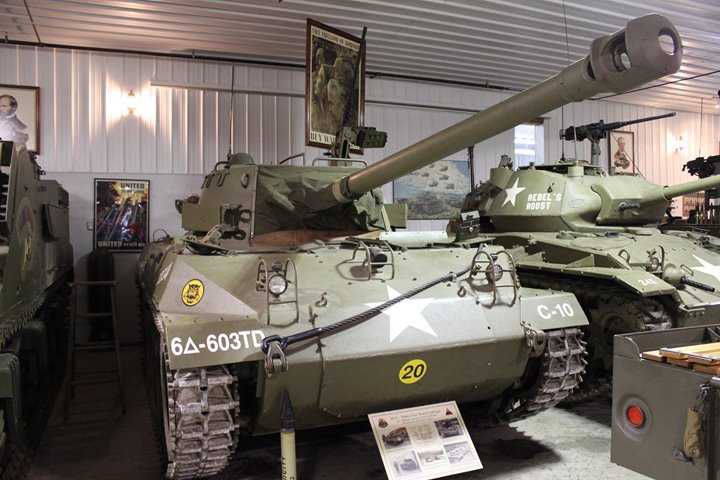
This M18 Hellcat is on display at the Ropkey
Armor Museum in Crawfordsville, IN. Author's photo added
12-27-2016. .
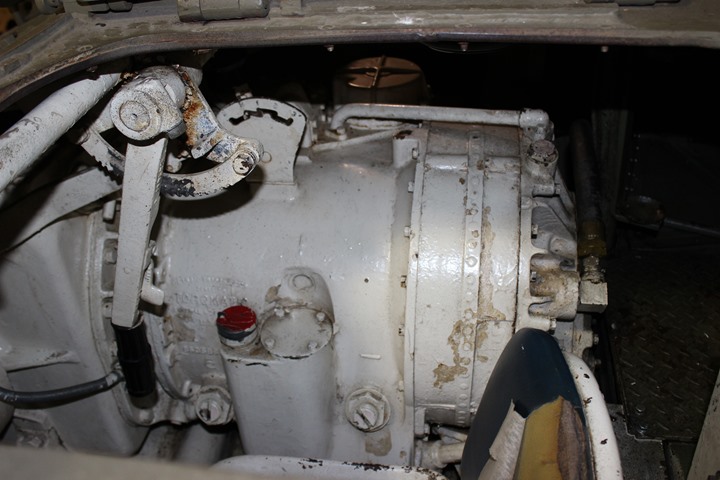
Here is the Torqmatic transmission.
Author's photo added 12-27-2016.
"A Friendly Welcome to the Fisher Body Division Die and
Machine Plant"
The following six page pamphlet was
distributed to
visitors for an open house held in the mid to late 1950s. After
the title page there is a three page history of Fisher Body, a page on
employee benefits, and then the last page stating some facts and
figures.
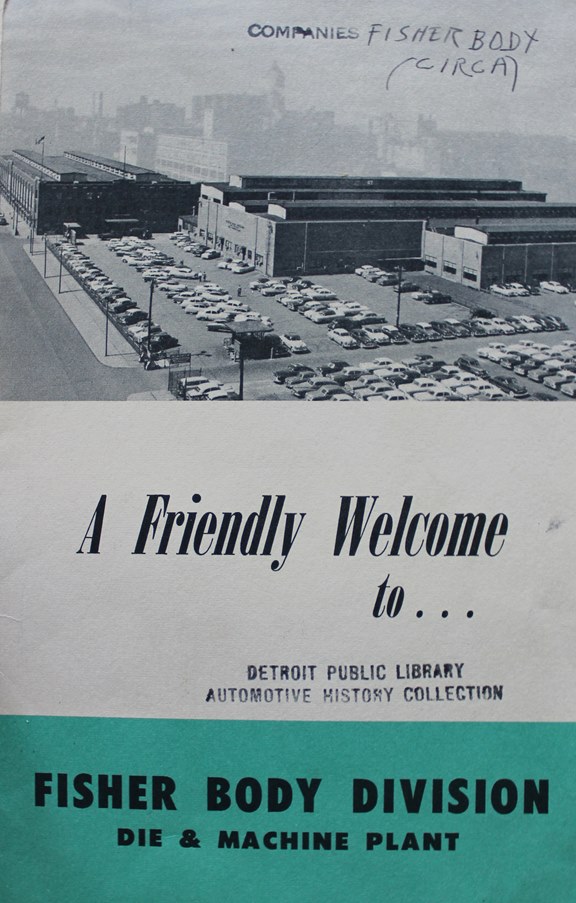
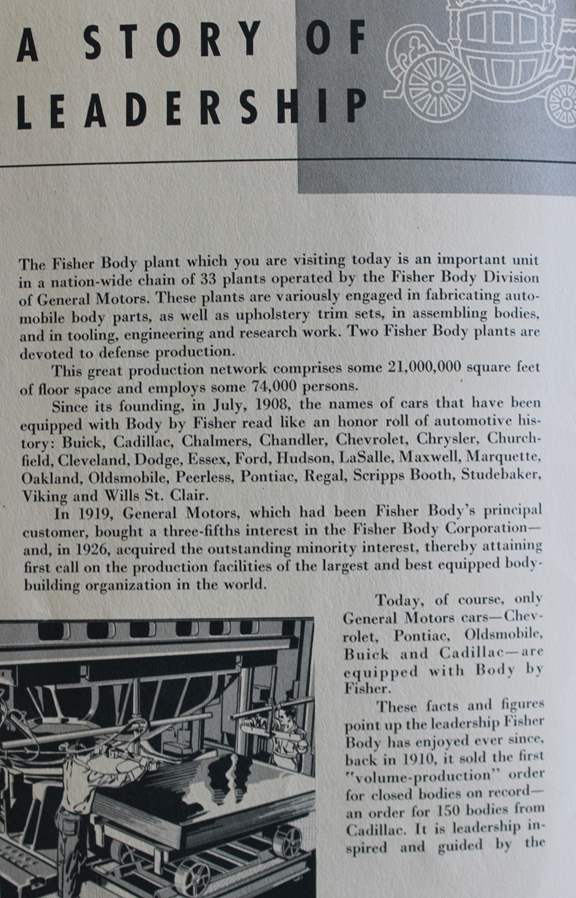
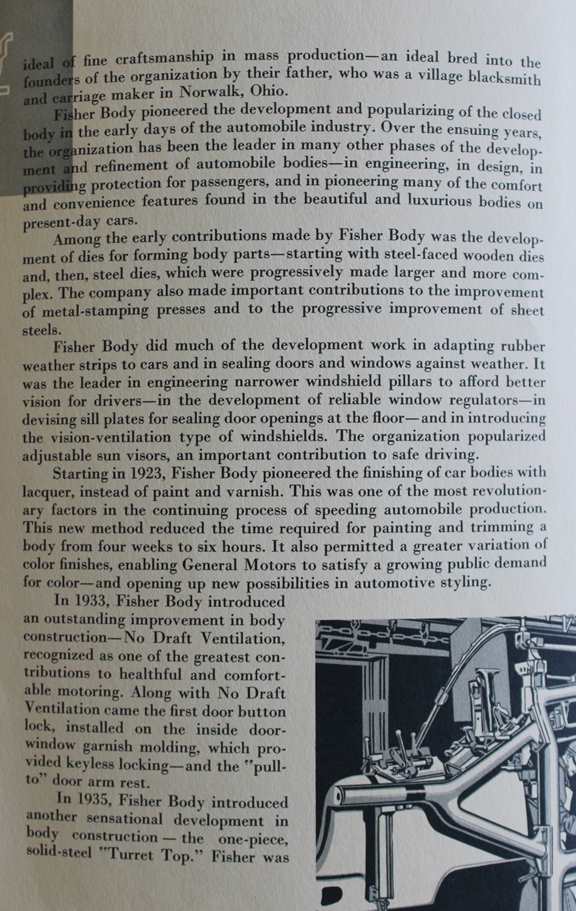
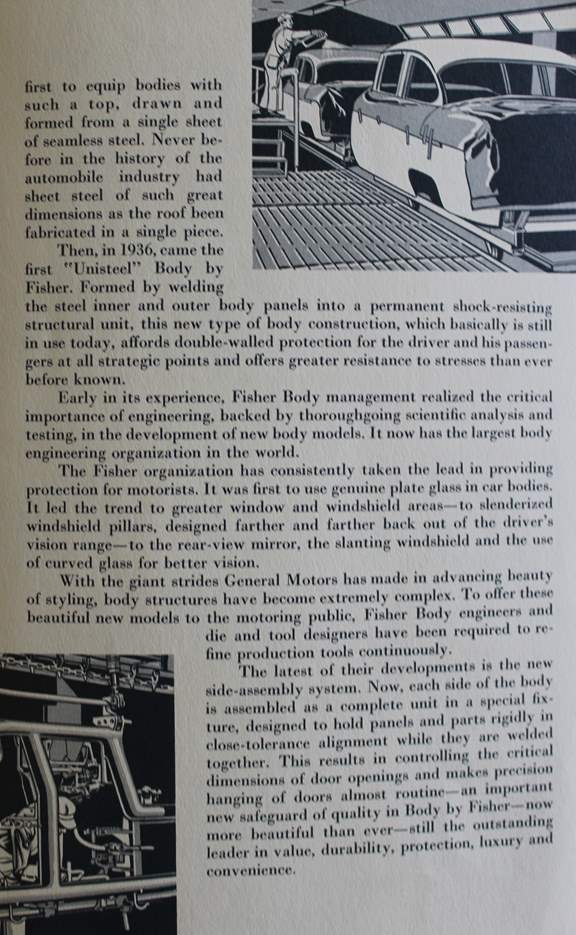
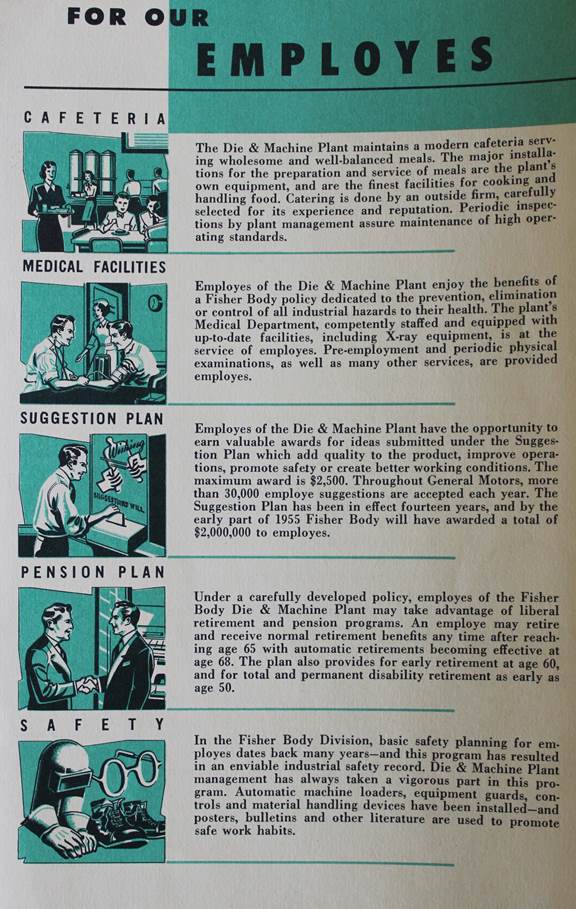
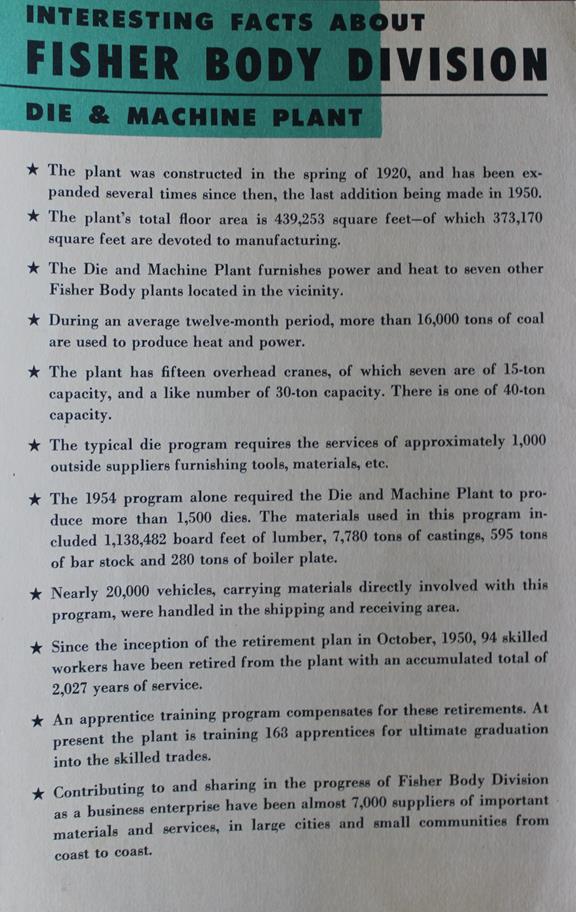
|














































































